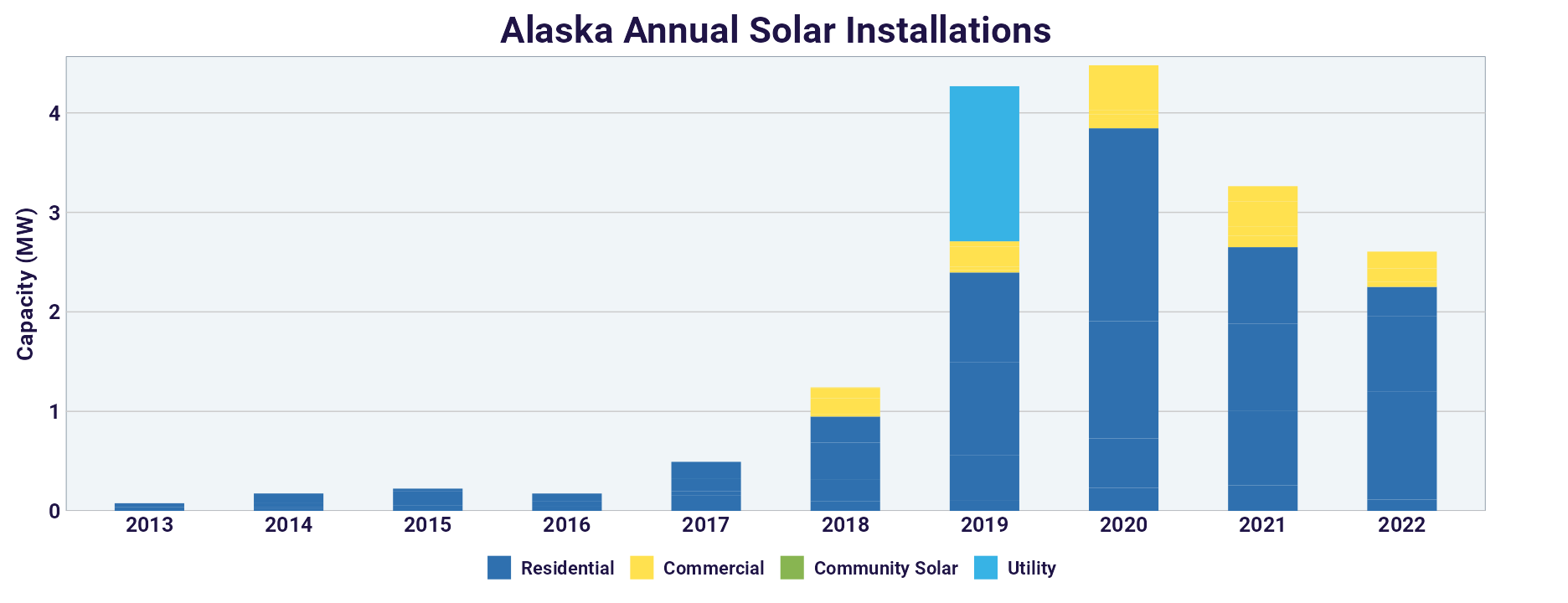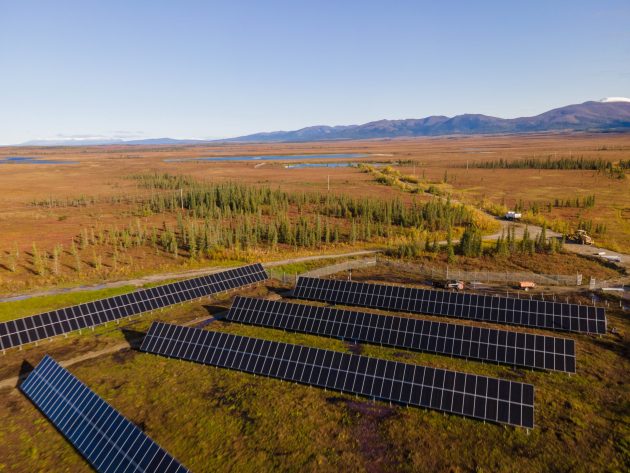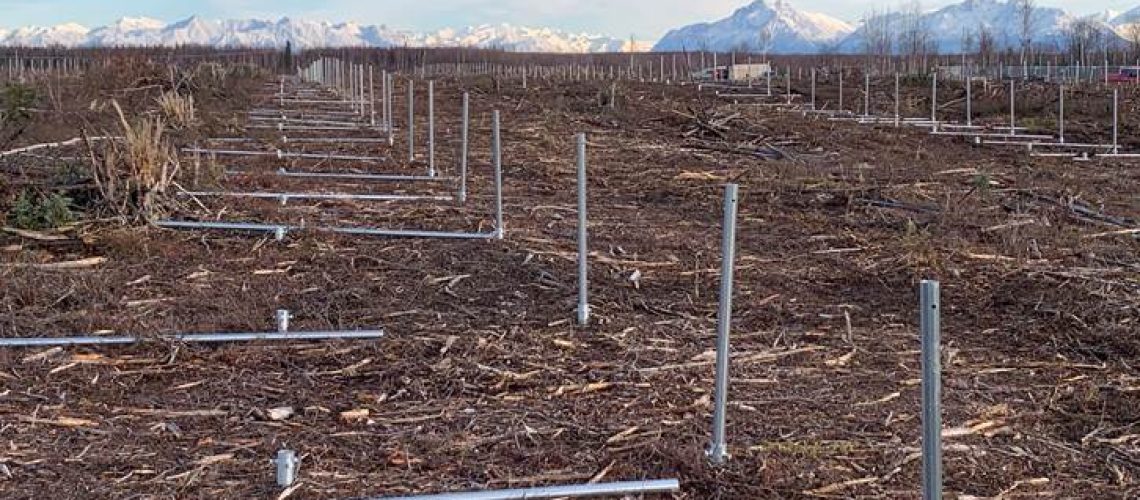Alaska enjoys the same level of solar insolation as Germany, yet ranks 49th in the United States in terms of solar capacity installed. Launch Alaska is working to change that.
Alaska is the largest state by area and the most sparsely populated U.S. state. With diminishing oil reserves and residents in extremely rural areas reliant on diesel fuel for power, it is surprising how little solar energy provides power to Alaskans. While one deterrent to relying on solar may be the lack of sun in the winter, particularly in northern areas, they also have an equal number of days of sunshine. According to the Department of Energy, annual insolation and thus, power production per capacity, is similar to Germany, which has been a leader in worldwide solar power use.
A similar insolation level, however, is where the comparison to European countries ends. Alaska has 18 MW of solar installed, according to the Solar Energy Industries Association (SEIA), ranking it 49th, down from 48th last year. Only South Dakota has less solar installed. The state receives 0.23% of electricity from solar. And while SEIA anticipates that 50 MW will be installed over next five years, Alaska will drop into last place in the U.S. for solar installations.
Unfortunately, this is in a state that has some of the highest electric rates (20.02 cents per kWh) per Energy Information Administration. A cost of living study by the Anchorage Economic Development Corporation revealed that utility costs in some cases are 33% higher than the national average.
Incentives
As in all states, federal incentives apply to solar projects in Alaska. The Inflation Reduction Act (IRA) of 2022 established an Investment Tax Credit that covers 30% of the installed system costs. Considered the most significant climate legislation in history, the IRA encourages clean energy adoption in overburdened communities. For example, the IRA includes the Justice40 Initiative, which supports programs that improve clean transit and workforce development while also investing in programs that make clean energy more affordable and accessible and strengthen resilience to climate change in underserved areas.

While federal support for solar adoption in all states is currently at an all-time high, Alaskan state policy lags behind. One policy, however, allows for municipalities to decide whether solar installations are property tax-exempt, meaning that even though the assessed value of property may rise as a result of a solar installation, property taxes will not rise correspondingly.
The state also has a net metering policy for systems of up to 25 kW. Payment for excess energy generation is credited to the customers’ next bill and it carries over indefinitely, according to DSIRE.
The state may soon have a renewable portfolio standard (RPS), as Alaska Senator Löki Tobin introduced Senate Bill 101 in March to establish a RPS for the Railbelt region in Alaska. Representative Jesse Sumner followed with House Bill 121, companion RPS legislation. The Railbelt is the interconnected power grid that runs from Fairbanks through Anchorage to the Kenai Peninsula. The legislation would require the five utilities in the area to generate 25% of their electricity from renewable resources by the end of 2027; 55% by the end of 2035; and 80% by the close of 2040. The bill aims to foster collaboration by imposing penalties only if the whole region fails to meet the standard.
Landmark installations
Energy49, a spinoff of Renewable Independent Power Producers (IPP), is the Alaskan solar developer of the 8.5 MW Houston solar project, which will be the largest installation in Alaska. Renewable IPP is also responsible for the 1.2 MW Willow solar project, previously the largest in the state.
Construction began last year on the Houston project, which is owned by New York-based CleanCapital, and expected to provide enough electricity to power 1,400 homes. The Alaska Energy Authority (AEA) provided a $4.9 million loan from its Power Project Fund to the project and CleanCapital provided the balance of project equity financing. Instrumental in getting the project off the ground is Launch Alaska, a non-profit with a goal of supporting deployment of $1 billion in climate tech projects across Alaska by 2030.
The Houston project, on track to be completed in August, will cover 45 acres with ballasted bifacial solar modules. Matanuska Electric Association has committed to purchasing all energy generated at the solar farm.
Another Alaskan solar installation was recently completed north of the Arctic Circle in the village of Shungnak, where residents had become accustomed to burning diesel fuel for its electricity.

A solar-plus-battery energy storage project funded by the Department of Agriculture and the Northwest Arctic Borough is changing how the village sources its electricity. With equipment developed by Blue Planet Energy, the solar and battery project forms a microgrid that is designed to meet the numerous challenges of operating in an extreme climate.
A 225 kW solar array offsets much of the village’s energy needs, which generally ranges between 200 kW and a peak of 300 kW. LG 405 W NeON 2 bifacial solar modules were selected for the array. The microgrid is intelligently designed to operate and supply power in times where diesel generation would be most expensive.
“Thanks to the energy storage system, we can turn the diesels off but keep the lights on in the community. It also gives the local utility the ability to run on 100% clean energy for hours at a time,” said Rob Roys, CIO, Launch Alaska.
Alaska’s future energy plan
Launch Alaska conducted a survey in early 2023 in which the IRA was shown to have major implications for Alaska project deployment. The non-profit will have a hand in Alaska’s future energy plan as Isaac Vanderburg, chief executive officer of Launch Alaska was recently appointed to the Governor’s Energy Security Task Force, charged with developing strategies to lower the cost of electricity statewide and think comprehensively about Alaska’s energy plan.
The pv magazine USA tour of 50 states of solar incentives last stopped in California, and will conclude the series with a final stop in Hawaii. For the full tour to date click here.



